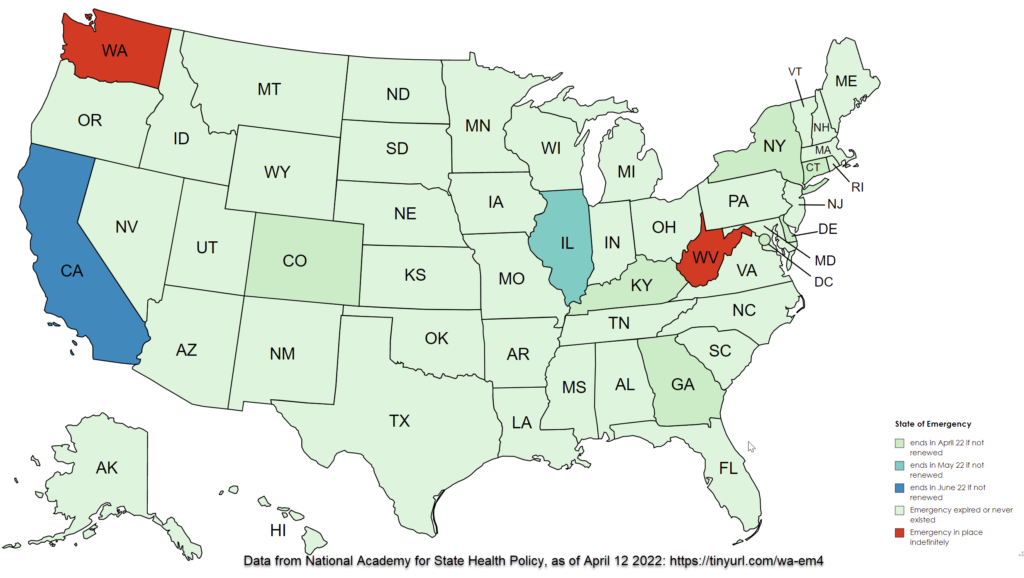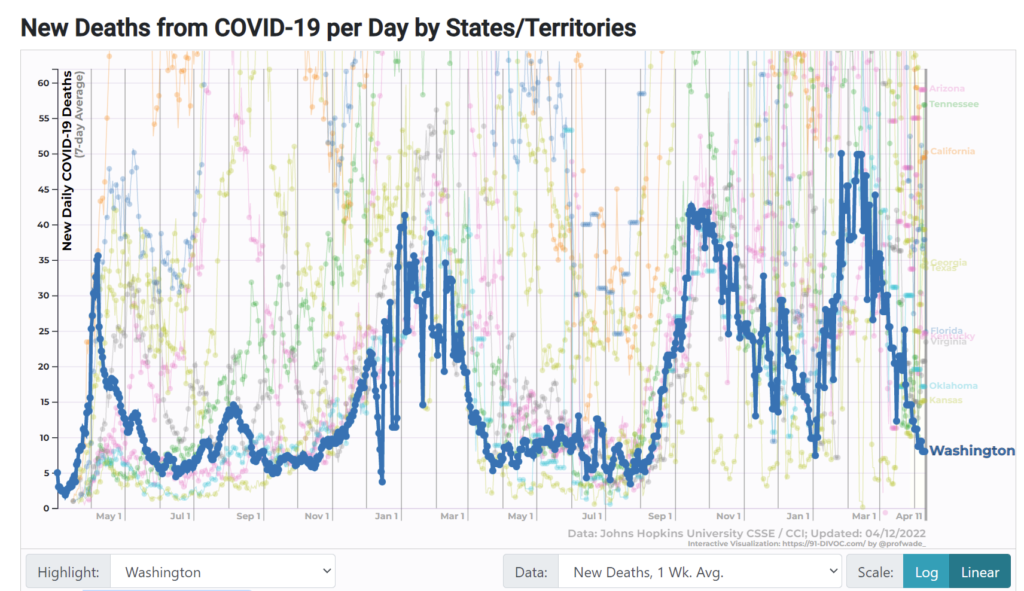It’s April 12th, 2022. Governor Jay Inslee has had State of Emergency powers for 772 days. He issued his emergency proclamation on February 29th, 2020, more than two years ago. He was the first governor in the nation to do so, making Washington State’s COVID emergency longer than any other.
Come Saturday, we are again completely alone in the Pacific Northwest in our heightened condition. Oregon rescinded its emergency powers declaration on April 1st, 2022. Idaho’s Governor Brad Little is ending their State of Emergency this Friday. Governor Dunleavy ended Alaska’s State of Emergency a year ago. Montana ended its State of Emergency last June.
We are significant outliers not just in the Pacific Northwest, but when compared with the nation as a whole. According to the National Academy for State Health Policy, only Washington State and West Virginia remain in an indefinite State of Emergency. Thirty-seven states either had no state of emergency or those declarations have already expired (lightest green.) Eleven more are set to expire later this month (slightly darker green.) One is set to expire in May (Illinois), and one in June (California.) In West Virginia, the Governor signaled in March that he’d end the State of Emergency soon but hasn’t done so yet. Local West Virginia news suggests that potential loss of federal health insurance money have likely driven him to delay.

The question which matters most is: are we in an emergency?
No matter how you evaluate it, the resounding answer is no. Statewide, just 2.04 people per 100,000 are hospitalized with COVID, not even necessarily due to COVID. In our entire state of 7,710,000 people, just 157 of us are hospitalized for any reason with a COVID-positive test, not even because we have COVID. Remember: most hospitals routinely test all patients upon admission in an abundance of caution. Therefore, patients hospitalized due to, say, highway accidents who then also test positive for mild, asymptomatic COVID will be counted in that 157 tally.
Even erroneously counting every single one of these hospitalizations as being caused by COVID, that’s a current hospitalization rate of 0.002% of our population. Are we in any imminent danger of “overwhelming” hospitals? No.
If this is an emergency, then everything is.
Inslee’s emergency declaration included eight “WHEREAS” justification statements. None of them seem timely or relevant at the moment. Better still, in terms of vaccination, we seem among the most prepared states for future waves, be they minor or major. According to the Washington State Department of Health dashboard, fully 81.5% of Washington’s population over 5 years old have received at least one vaccination dose, and 74% are fully vaccinated. Vaccination will be ongoing and at people’s discretion, with many starting to get their second booster shot. Thankfully, that groundwork for optional self-protection for those most at risk has been laid.
How’s hospitalization trending? I tried to get an accurate hospitalization trend chart from the State of Washington Department of Health dashboard, but was greeted by this:

In what kind of Emergency do we shut down reporting of detailed hospitalization trends?
If you look at deaths with COVID (again, not necessarily due to COVID), the folks at 91-DIVOC have a helpful chart. Does this say “emergency” to you?

Even if you look just at case rates, there’s no need for alarm. Omicron is a milder variant, which results in lower severity of outcome:
Why is this continuing?
The Governor said the quiet part out loud in his response to KOMO’s Keith Eldridge on Monday: “We want to make sure that federal money keeps coming, so it’s important to keep this in place right now.”
I’m sorry, Governor, but how is that not fraud? I know, that’s a pretty bold accusation, but let’s open the dictionary. Fraud is defined as “wrongful deception intended to result in financial gain.” This is clearly deception. There’s no COVID emergency currently in our state, and there hasn’t been for months.
Or, we can put aside the dictionary, and simply look to legalese. How does Washington State Law define an “emergency?”
The Revised Code of Washington (RCW) 38.52.010 states:
‘Emergency or disaster‘ as used in all sections of this chapter except RCW 38.52.430 means an event or set of circumstances which: (i) Demands immediate action to preserve public health, protect life, protect public property, or to provide relief to any stricken community overtaken by such occurrences; or (ii) reaches such a dimension or degree of destructiveness as to warrant the governor proclaiming a state of emergency pursuant to RCW 43.06.010.”
Do these conditions still exist?
Every Washingtonian knows that the conditions since 2020 have dramatically changed. We are no longer in lockdown. We are no longer required to wear masks. Kids have been back in school in every district in our state for months. County cases and hospitalizations are low and have been for months.
Bit by bit, the various mandates which were imposed during the State of Emergency are being rescinded. Inslee’s decided that drivers license renewal and learner permit extensions can now expire (proclamation April 1st 2022). He’s decided a mask mandate isn’t necessary; that ended March 12th 2022. Even Seattle’s City Council let the long-lasting eviction moratorium imposed during COVID finally expire.
Adding to the absurdity, both Inslee and his Lt. Governor went on vacation recently. I have no problem with them taking time off, but how can one possibly take a vacation during a state of emergency?
Former White House Chief of Staff Rahm Emmanuel had a famous quip: “Never let a crisis go to waste.” For Inslee, this appears to have a corollary: Preserve the crisis.

